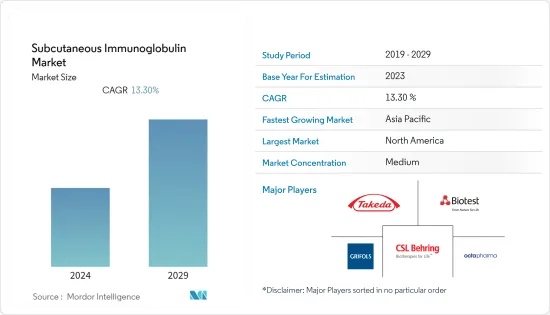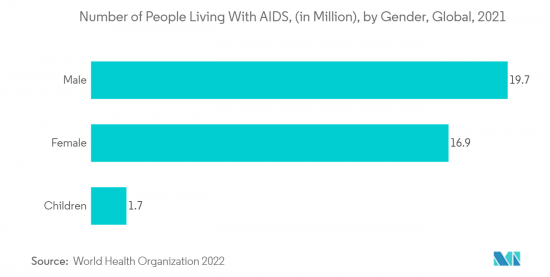PUBLISHER: Mordor Intelligence | PRODUCT CODE: 1405715

PUBLISHER: Mordor Intelligence | PRODUCT CODE: 1405715
Subcutaneous Immunoglobulin - Market Share Analysis, Industry Trends & Statistics, Growth Forecasts 2024 - 2029

The subcutaneous immunoglobulin market studied was projected to grow with a CAGR of nearly 13.3% over the forecast period.
The COVID-19 pandemic had a significant impact on the market studied. Some biopharmaceutical companies, such as Merck & Co. Inc. and Eli Lilly and Company, announced clinical trial delays due to the pandemic. For instance, data from ClinicalTrials.gov published in November 2022 indicated that more than 200 interventional oncology studies were suspended due to the COVID-19 pandemic. In addition, 60% of institutions in the United States and 86% in Europe enroll new patients at a lower rate. Therefore, it was observed that the pandemic significantly affected the market growth. However, currently, the market has reached its-pandemic nature in terms of research and is expected to witness strong growth.
The major factors attributing to the growth of the market include the increasing use of subcutaneous immunoglobulin for primary immunodeficiency disorders, the increasing geriatric population, and the patient pool.
The increasing burden of immuno-deficiency diseases such as HIV is propelling market growth. For instance, as per the data from NACO published in August 2022, there were around 2.4 million HIV cases in India during the year 2022. Similarly, the data further stated that the number of HIV patients is still high across various countries such as South Africa, and Nigeria which is believed to contribute significantly to the market growth in the coming years.
Furthermore, as per the Wiley Online Library article published in April 2022, it was indicated that up to 1 in 25,000 people worldwide are born with common variable immunodeficiency (CVID), a genetic disorder that can cripple patients' immune defenses. The data also stated that the overall burden of CVID is on the rise in recent years which is the leading factor responsible for the market growth.
However, the stringent government regulations and the high risk of the side effects of the treatment are some of the factors restraining market growth.
Subcutaneous Immunoglobulin Market Trends
Secondary Immunodeficiency Diseases are Expected to Witness a Strong Growth Over the Forecast Period
AIDS, cancers of the immune system, like leukemia. and immune-complex diseases, like viral hepatitis, are some of the most common examples of secondary immunodeficiency diseases. With the growing burden of the above-mentioned diseases, the segment is believed to witness strong growth in the coming years.
According to the data updated by WHO in July 2022, it was observed that there were around 38.4 million people across the globe living with AIDS in the year 2021. Furthermore, there were approximately 1.5 million new AIDS cases were identified globally in 2021. Among the infected people, 1.7 million were children which is creating a significant burden on the global healthcare industry. Hence, with the high prevalence of secondary immunodeficiency diseases such as AIDS, the segment is expected to grow significantly over the forecast period.
Furthermore, the increasing approvals of drug candidates for secondary immunodeficiency are boosting segment growth. For instance, in January 2022, Octapharma announced that the indication for cutaquig, a human immunoglobulin for subcutaneous administration, was expanded in the European Union (EU), providing more flexible treatment options to a far wider range of patients with secondary immunodeficiency.
The new Global Health Sector Strategies (GHSS) on HIV, viral hepatitis, and sexually transmitted infections, 2022-2030, are seen as an opportunity to refocus global efforts, speed up the response, and recommit to the elimination of viral hepatitis by 2030, according to participants in the third World Hepatitis Summit. Hence, with the increasing focus of various countries on eliminating such diseases, it is expected that there will be a growing demand for immunoglobulin which is believed to propel the segment growth over the forecast period.

North America Dominates the Market and Expected to do Same in the Forecast Period
North America is expected to dominate the overall subcutaneous immunoglobulin market, throughout the forecast period. The market growth is due to the factors such as the presence of key players, the high prevalence of immunodeficiency disease patients, the increasing geriatric population in the region, and the established healthcare infrastructure.
As per the data from the American Cancer Society Report 2022, there were an estimated 1.9 million new cancer cases in the United States for the year 2022. Among those, breast cancer, and cancers of the genitals were expected to witness the highest numbers. The report further stated that the burden of cancer in the United States is increasing rapidly which is providing opportunities to the healthcare companies operating in the therapeutics business. Hence, with the high burden of cancer in the United States, the market for subcutaneous immunoglobulin is expected to witness strong growth in the coming years.
Additionally, Canada is also facing a huge burden of cancer in recent years. As per the data from the Government of Canada published in November 2021, it was projected that the number of people living with cancer would reach 229,200 in the year 2021. By accounting for 46% of all diagnoses in 2021, lung, breast, colorectal, and prostate cancers were anticipated to continue being the most frequently diagnosed cancers.
Several key developments are occuring in the United States which is fueling the market growth. For instance, in January 2023, KORU Medical Systems, Inc., one of the leading medical technology companies operating in the drug delivery systems business, announced a development agreement with a pharmaceutical manufacturer of subcutaneous immunoglobulin therapy (SCIg) to develop and seek regulatory approval of the Freedom Infusion System with a SCIg prefilled syringe.
Therefore, looking at the above-mentioned statistics, it is indicated that with the rising burden of cancers in North American countries, there will be growing demand for immunoglobulin which is expected to boost the market growth in coming years.
Subcutaneous Immunoglobulin Industry Overview
The subcutaneous immunoglobulin market is moderately competitive and consists of several major players. Some of the companies which are currently dominating the market are Takeda Pharmaceutical Company Limited, Biotest AG, CSL Behring, Grifols, S.A., Octapharma AG, Kedrion S.p.A., Bio Products laboratory.
Additional Benefits:
- The market estimate (ME) sheet in Excel format
- 3 months of analyst support
TABLE OF CONTENTS
1 INTRODUCTION
- 1.1 Study Assumptions and Market Definition
- 1.2 Scope of the Study
2 RESEARCH METHODOLOGY
3 EXECUTIVE SUMMARY
4 MARKET DYNAMICS
- 4.1 Market Overview
- 4.2 Market Drivers
- 4.2.1 Increasing Use of Subcutaneous Immunoglobulin For Primary Immunodeficiency Disorders
- 4.2.2 Increasing Geriatric Population and Patient Pool
- 4.2.3 Rise in Government Funding
- 4.3 Market Restraints
- 4.3.1 Stringent Government Regulations
- 4.3.2 High Risk of Side Effects
- 4.4 Porter's Five Force Analysis
- 4.4.1 Threat of New Entrants
- 4.4.2 Bargaining Power of Buyers/Consumers
- 4.4.3 Bargaining Power of Suppliers
- 4.4.4 Threat of Substitute Products
- 4.4.5 Intensity of Competitive Rivalry
5 MARKET SEGMENTATION
- 5.1 By Application
- 5.1.1 Primary Immunodeficiency Diseases
- 5.1.2 Secondary Immunodeficiency Diseases
- 5.1.3 Others
- 5.2 By End-User
- 5.2.1 Hospitals
- 5.2.2 Homecare Settings
- 5.2.3 Others
- 5.3 Geography
- 5.3.1 North America
- 5.3.1.1 United States
- 5.3.1.2 Canada
- 5.3.1.3 Mexico
- 5.3.2 Europe
- 5.3.2.1 Germany
- 5.3.2.2 United Kingdom
- 5.3.2.3 France
- 5.3.2.4 Italy
- 5.3.2.5 Spain
- 5.3.2.6 Rest of Europe
- 5.3.3 Asia-Pacific
- 5.3.3.1 China
- 5.3.3.2 Japan
- 5.3.3.3 India
- 5.3.3.4 Australia
- 5.3.3.5 South Korea
- 5.3.3.6 Rest of Asia-Pacific
- 5.3.4 Middle-East and Africa
- 5.3.4.1 GCC
- 5.3.4.2 South Africa
- 5.3.4.3 Rest of Middle-East and Africa
- 5.3.5 South America
- 5.3.5.1 Brazil
- 5.3.5.2 Argentina
- 5.3.5.3 Rest of South America
- 5.3.1 North America
6 COMPETITIVE LANDSCAPE
- 6.1 Company Profiles
- 6.1.1 Takeda Pharmaceutical Company Limited
- 6.1.2 Biotest AG
- 6.1.3 CSL Behring
- 6.1.4 Grifols, S.A.
- 6.1.5 Octapharma AG
- 6.1.6 Kedrion S.p.A.
- 6.1.7 Bio Products laboratory
7 MARKET OPPORTUNITIES AND FUTURE TRENDS




